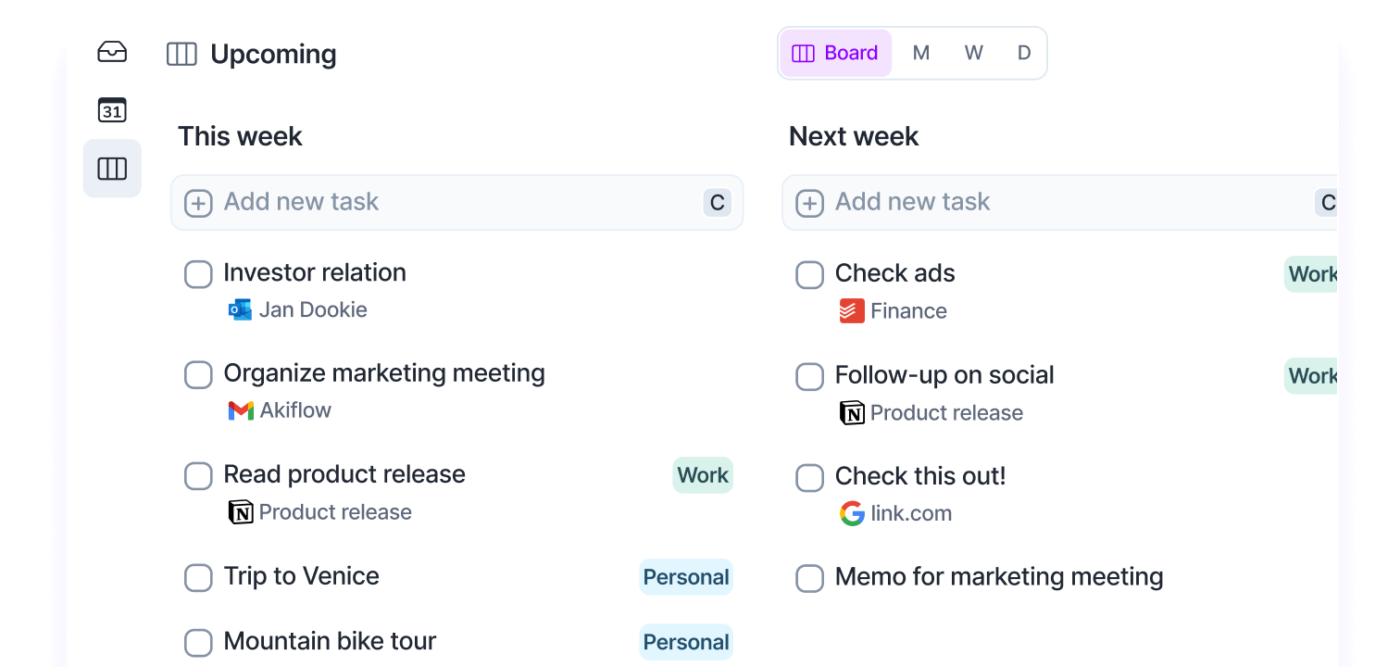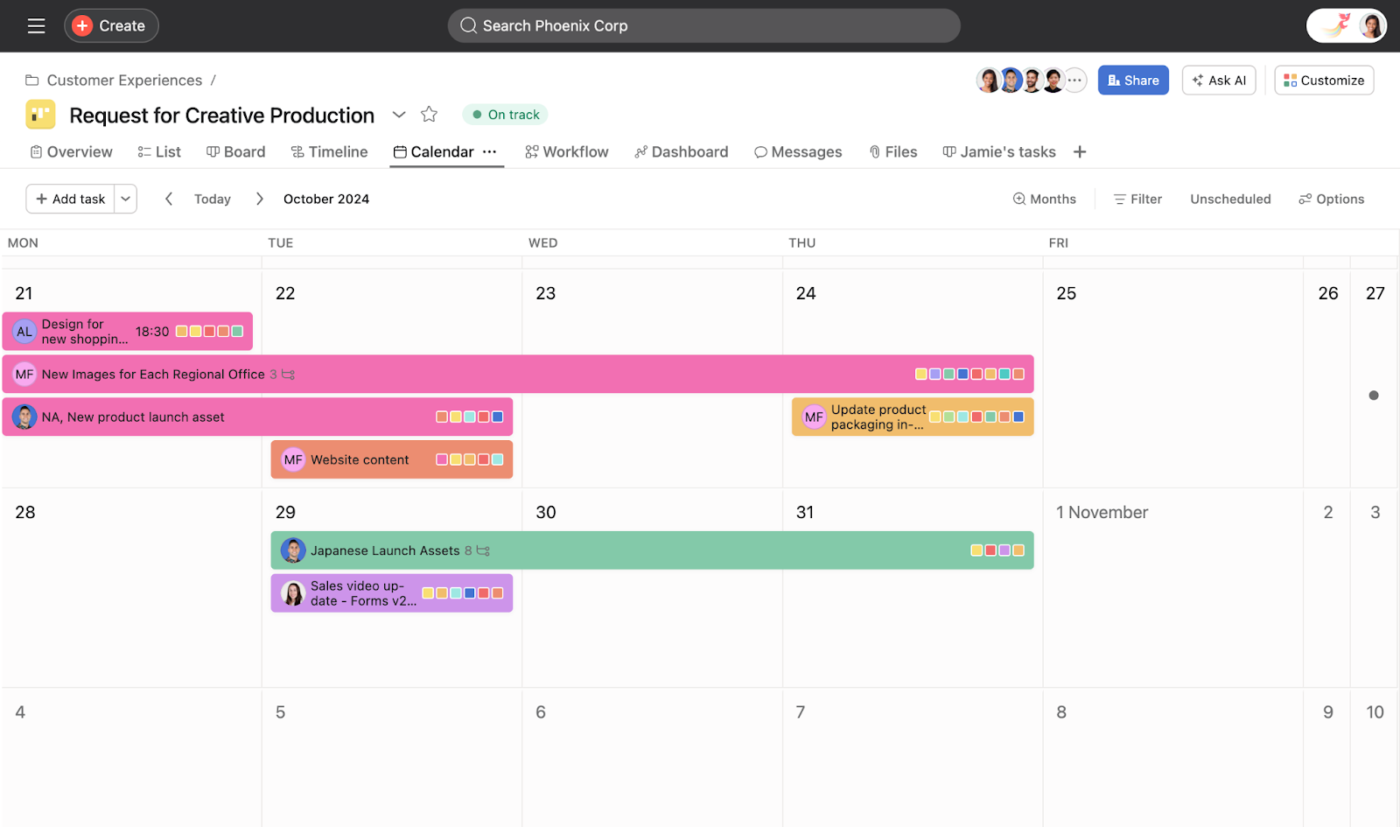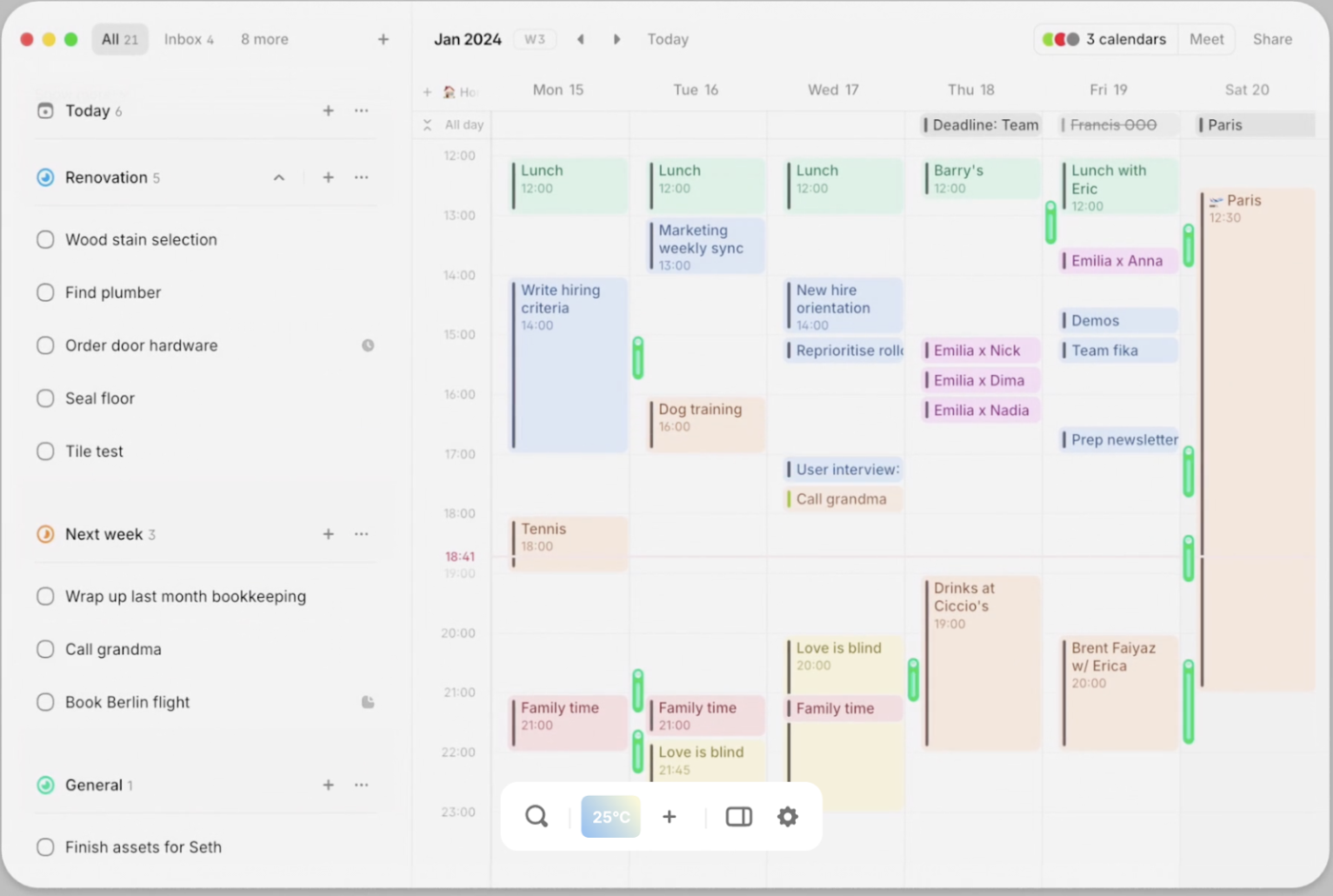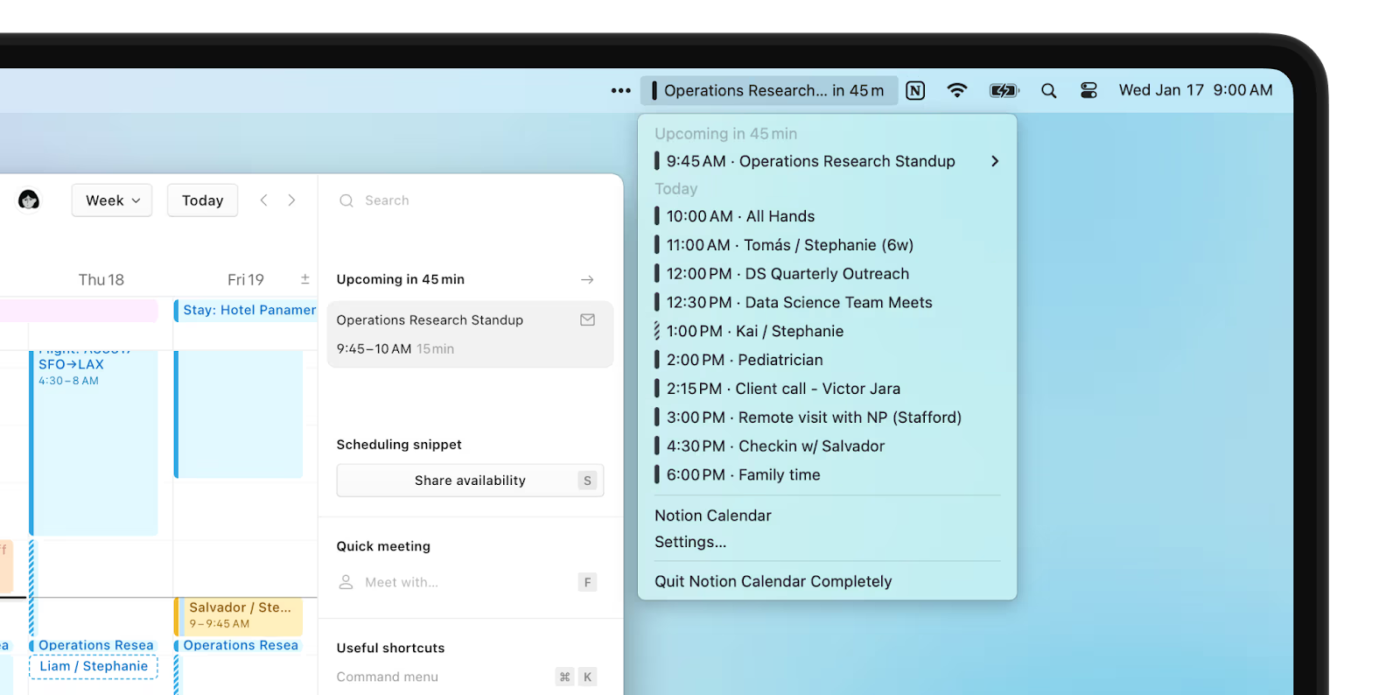Top 10 Sunsama Alternatives for Calendar Management in 2025

Sorry, there were no results found for “”
Sorry, there were no results found for “”
Sorry, there were no results found for “”

You’ve got a plan for the day with your team members, but it lives in five different tools.
There’s one for tasks, one for your calendar, and one for notes. And none of them talk to each other.
That’s the problem with relying on a minimalist planner like Sunsama. It’s suitable for solo daily project planning, but things get messy fast when your work involves multiple complex projects, recurring schedules, or team collaboration. You’re left to constantly jump between tabs, fill gaps manually, and enforce the same setup every morning.
If that sounds familiar, it’s time for a switch. We’ve rounded up smarter alternatives to Sunsama, including free calendar management apps. These alternatives are built for focused planning and deeper task management. They come with collaborative project management calendars and automation capabilities, too!
👀 Did You Know? The digital planner app market will soon touch $3.5 billion as more professionals shift from physical planners to smarter, more flexible digital tools.
Sunsama works well for simple daily plans. However, as projects grow and priorities shift, you need more than basic organization; you need a tool that adapts.
That’s when many users start looking for a capable task management app.
Here’s what Sunsama doesn’t cover, especially when your workday starts demanding more flexibility, speed, and structure:
You’ve seen where Sunsama falls short. Now, let’s look at tools that do more. From planning and scheduling to real-time collaboration, here are the best alternatives worth considering.
| Tool | Key features | Best for | Pricing* |
| ClickUp | AI scheduling, Tasks, Docs, Calendar—all-in-one, AI assistant, AI Notetaker | Enterprises, teams or individuals who need a single tool to manage projects, tasks, and schedules in a connected workspace | Free plan available; customizations available for enterprises |
| Akiflow | Universal inbox, calendar time-blocking, task capture, integrations, focus timer | Users juggling tools like Slack, Gmail, and Trello—helps centralize everything into one daily plan | Free trial available; paid plans start at $34/month |
| Reclaim | Smart scheduling, AI rescheduling, calendar sync, task syncing, focus time protection | Teams and individuals who want to automate scheduling and protect deep work blocks | Free plan available; paid plans start at $10/month |
| Motion | AI prioritization, auto-scheduling, task calendar, meeting booking, time blocking | High-performing professionals who want their schedule built automatically | Free trial available; paid plans start at $49/month; custom pricing for enterprises |
| Asana | Multiple project views, goal alignment, rules automation, reporting, project timelines | Cross-functional teams that need a framework to plan, assign, and track structured work | Free plan available; paid plans start at $13.49/month; custom pricing for enterprises |
| Amie Calendar | AI meeting notes, email + task + calendar integration, clean UI, personal + work account switcher | Individual users who want to manage notes, meetings, and calendars in one visually simple tool | Free trial available; paid plans start at $25/month; custom pricing for enterprises |
| Any.do | My Day planner, recurring reminders, voice input, calendar sync, location-based tasks | Individuals who want a clean, minimal interface to manage daily to-dos and reminders | Free plan available; paid plans start at $7.99/month |
| Todoist | Quick Add, recurring tasks, labels + filters, calendar integration, priority levels | Solo users who want a lightweight task manager that doesn’t sacrifice smart features | Free plan available; paid plans start at $4/month |
| Notion | Modular blocks, Calendly integrations, database relations, wikis, docs + tasks in one | Creators or teams who want full control over how their workspace is built and organized | Free plan available; paid plans start at $12/month; custom pricing for enterprises |
| TickTick | Habit tracker, Pomodoro timer, Eisenhower Matrix, calendar views, multi-device sync | Users who want to manage their to-dos and build habits in the same app | Free plan available; paid annual plan for $35.99 |
Our editorial team follows a transparent, research-backed, and vendor-neutral process, so you can trust that our recommendations are based on real product value.
Here’s a detailed rundown of how we review software at ClickUp.
Not every calendar app works the way you do. Whether you need time-blocking, AI scheduling, habit tracking, or a connected workspace, these Sunsama alternatives offer smarter ways to plan your day:
Most planning tools help you block time. ClickUp—the everything app for work—enables you to build momentum.
It’s more than just a planner tool; it’s a better alternative with a complete workspace that brings all your work (tasks, meetings, calendar, docs) into one place so you don’t have to piece together your day across different apps.
With ClickUp, your calendar is tied directly to your work and conversations. You can drag tasks into your schedule to block focus time, join meetings in one click directly from the toolbar, and switch between daily or weekly views in addition to zooming out month-on-month. Managing overdue or priority work is also easier, thanks to a single sidebar that consolidates your ongoing and planned tasks.

Need to reschedule something? Simply adjust the time by dragging and dropping the task or meeting into a preferred slot. And because your ClickUp Calendar syncs with Google Calendar, supports time zone changes, offers AI-powered scheduling, and connects to every layer of your workflow, you’re not just organizing your day—you’re managing real projects with real deadlines.
Add context to every calendar block by linking connected ClickUp Docs and Tasks in the event description. Invite the ClickUp AI Notetaker to your meetings from within the Calendar to auto-record, transcribe, and summarize key takeaways without manually jotting down notes.

ClickUp Tasks tie directly into your calendar so you can plan, prioritize, and act without micromanaging your day. You can assign start and due times to tasks to see exactly how your day is mapped out—color-coded and easy to visualize. Events you add to your calendar can even show up in ClickUp as tasks or reminders (depending on your setup). So your calendar becomes a real-time, accurate reflection of what needs to be done and when.
ClickUp further consolidates work by creating tasks from your ClickUp Chat, Docs, and action items while automating assignments, status updates, and recurring workflows. Label tasks as milestones, bugs, or ideas for easy tracking. Convert form submissions into tasks, routing them to the right lists. Real-time dashboards track progress, and Custom Task Statuses help adapt the setup to your workflow.
The ClickUp Calendar Planner Template helps you map out daily tasks, events, deadlines, and priorities in one place to move faster and plan smarter.
With this template:
ClickUp Brain, the native AI assistant, does more than remind you what’s next. It handles scheduling and follow-ups and suggests rescheduling tasks based on shifting priorities. It’s like having a personal assistant who syncs across your tasks, chats, meetings, and time zones.

Brain can also create follow-ups and surface critical insights from meeting notes, adapt recurring events based on natural language input, and share context in Chat messages before calls.
A G2 user loves the AI-powered Calendar in ClickUp:
New calendar & Gantt upgrades make planning less painful. The March 2025 refresh merged tasks, docs, chats, and meetings into a single calendar view and added AI-powered time blocking; Gantt charts load noticeably faster and keep the zoom level persistent.
📮ClickUp Insight: 18% of our survey respondents want to use AI to organize their lives through calendars, tasks, and reminders. Another 15% want AI to handle routine tasks and administrative work. To do this, an AI needs to be able to: understand the priority levels for each task in a workflow, run the necessary steps to create tasks or adjust tasks, and set up automated workflows.
Most tools have one or two of these steps worked out. However, ClickUp has helped users consolidate up to 5+ apps using our platform! Experience AI-powered scheduling, where tasks and meetings can be easily allocated to open slots in your calendar based on priority levels. You can also set up custom automation rules via ClickUp Brain to handle routine tasks. Say goodbye to busy work!
📖 Also Read: Sunsama vs. ClickUp: Which Planner App Is Best?

If your tasks are spread across Slack, Gmail, Trello, and a dozen other tools, Akiflow brings them all together. It’s built for people who want a streamlined view of their workload for project tracking; no jumping between tabs or digging for to-dos.
Everything gets pulled into one daily plan so you can focus on what needs to be done, not where it lives. It’s a solid option for anyone who’s outgrown manual methods or basic task scheduling tools and wants more control without constantly switching tools.
A Capterra review reads:
Takes some getting used to all features, but there are loads of tutorials. It improves my productivity, being super easy to create tasks on the fly (so I don’t forget them later), track work completed per #tag (i.e. projects).

If you want your calendar to work for you and not just display your chaotic timetable, Reclaim can help. It uses AI task tracking to automatically schedule your tasks, habits, and meetings based on real-time availability and shifting priorities.
The tool defends your focus time, protects “no-meeting” blocks, and builds in breaks so your day doesn’t feel like a nonstop blur. It’s a good choice for anyone exploring smarter AI calendar solutions that adapt to how you work instead of the other way around.
A G2 review says:
Instead of spending time on tedious daily and weekly calendar organization, I now just make a few clicks, and it takes care of everything automatically..

Motion takes a different approach to planning. Unlike many other project management tools, it doesn’t just organize your schedule; it builds it for you. Its AI automatically prioritizes tasks, slots them into your calendar, and adjusts them when things shift. Instead of manually reworking your day after every new meeting or deadline, Motion re-optimizes your time.
This makes it an ideal alternative for people with packed calendars who still want to focus on the right work at the right time.
A G2 review reads:
Motion solves the biggest issue I had with time boxing, which was frequently something would come up which would prevent me from working or completing the task I had blocked off time to do.
📖 Also Read: Best Meeting Management & Agenda Software Solutions

Asana is built for teams that live and breathe structured workflows. It connects tasks to larger goals, keeps everyone aligned on priorities, and gives project managers visibility without micromanaging.
With multiple ways to view projects (calendar, list, timeline), it’s easy to map out your day or week and see how individual tasks roll into broader initiatives. If your team needs more structure in communicating and executing work, Asana pairs strong planning features with solid team communication tools to keep everything in sync.
A Capterra review reads:
Our creative team uses Asana to keep track of all tasks and calendars. It is really important to the organization of our projects. Some users would be completely lost without it.
🧠 Fun Fact: The name “Asana” comes from a Sanskrit word for seated poses in yoga, symbolizing focus, balance, and flow in teamwork.

Amie Calendar blends scheduling and note-taking into a single, well-designed interface. It’s built for users who want more than just a functional calendar: a workspace that feels fast, lightweight, and enjoyable.
You can use it to take meeting notes, schedule tasks in natural language, manage emails, and toggle between personal and work accounts in seconds.
If your day is packed with back-to-back meetings and tasks, Amie gives you a clean, focused space to plan and capture everything in one flow. It also plays well with other online meeting tools you already use.
A Reddit review says:
I really like Amie. It’s beautiful and meets my needs… The interactive interface on iOS is also very novel, but it’s really heartbreaking that there is no Android version, and they don’t have a webpage adapted to mobile browsers.

Any.do is perfect for anyone who wants to stay on top of their daily to-dos without the bells and whistles of fancy apps. It keeps things simple with clean lists, recurring reminders, and a focused daily planner. You can quickly jot down tasks, get nudges throughout the day, and even use location-based reminders for errands or on-the-go tasks.
If you’re looking for a lightweight alternative to complex productivity apps, Any.do pairs well with flexible to-do list templates as well.
A G2 review reads:
Any.do is an excellent platform to organise tasks and help to keep us on track. Any.do send reminders, and we can set deadlines for the tasks. We can share the to-do lists and tasks with our colleagues. Any.do allow us to integrate calendars like Google Calendar, which helps us with reminders, and we can also check all our tasks on Google Calendar.

Todoist stands out for its clean, clutter-free interface for task management. Whether you’re scheduling your week or capturing quick ideas on the go, Todoist keeps it simple without sacrificing power.
Tasks sync directly to your calendar; the natural language input means you can add “Follow up next Friday at 10 am,” and it works. It’s a go-to choice for anyone who values minimalism, smart task handling, and practical productivity hacks.
A G2 review reads:
It is a simple and quick task software. It is very simple to add tasks. The learning curve is also very easy compared to other task softwares. I use it everyday, I can put something in it and have it remind me or show up in my task list days later.
👀 Did You Know? Todoist has a built-in Karma system that rewards you with points for completing tasks and keeping up streaks, gamifying productivity.

Notion brings your notes, tasks, projects, and calendars into one flexible workspace. You can create custom dashboards that show your weekly priorities alongside project timelines, write meeting notes next to your task list, and manage your schedule in context, not in isolation.
Whether you’re tracking goals, planning content, or organizing personal work, Notion gives you complete control over how your workspace looks and functions. It’s beneficial if you prefer building your own content calendar templates instead of using rigid, pre-built systems.
A G2 review reads:
One of the features I particularly like about Notion is its remarkable flexibility and versatility. It serves as a unified workspace where you can combine various elements such as text, images, tables, databases, and multimedia content seamlessly.

Going beyond task management, TickTick is an excellent alternative for people who want to stay productive and build better habits. It combines a daily planner, a calendar view, and a built-in habit tracker to manage your priorities and track your progress in one place.
Whether you’re running through a to-do list, blocking time to focus, or tracking streaks for new habits, TickTick makes it easy to stay consistent. This one fits the bill if you’re looking for a planner that helps you do as well as grow.
A Capterra review says:
I liked the idea that I could use the software as a one-stop shopping for my calendar, to-do list, and more. The idea of combining a calendar for those tasks that had a due date and a to-do list for tasks that didn’t was very appealing.
If your day is spread across calendars, task apps, meeting tools, and note-taking docs, you’re working twice as hard to stay organized. That’s where ClickUp changes the game.
Instead of stitching together a planner from different tools, you get one connected workspace that adapts to how you plan, prioritize, and execute. Whether you’re a solo planner or someone leading a team, ClickUp’s project management software brings everything under one roof so nothing slips through the cracks.
Try ClickUp as a free Sunsama alternative and turn your calendar into an engine for real progress.
© 2025 ClickUp